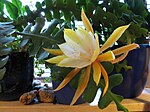| Disocactus | |
|---|---|

| |
| Disocactus biformis | |
| Scientific classification | |
| Kingdom: | Plantae |
| Clade: | Tracheophytes |
| Clade: | Angiosperms |
| Clade: | Eudicots |
| Order: | Caryophyllales |
| Family: | Cactaceae |
| Subfamily: | Cactoideae |
| Tribe: | Hylocereeae |
| Genus: | Disocactus Lindl. |
| Type species | |
| Disocactus biformis | |
| Species | |
Disocactus is a genus of epiphytic cacti in the tribe Hylocereeae found in Central America, the Caribbean and northern South America. It should not be confused with Discocactus, which is a different genus.
Species of Disocactus grow in tropical regions either on trees as epiphytes or on rocks as lithophytes. They have two distinct growth habits. Species such as D. phyllanthoides have stems which are round at the base but then become flattened and leaflike.
Many of the cultivated plants known as epiphyllum hybrids or just epiphyllums are derived from crosses between species of Disocactus (rather than Epiphyllum) and other genera in the Hylocereeae.
Description
| This section does not cite any sources. Please help improve this section by adding citations to reliable sources. Unsourced material may be challenged and removed. (November 2022) (Learn how and when to remove this message) |
The species of the genus Disocactus grow as epiphytes or lithophytes and are shrubby, profusely branched, hanging, up to 3 m long. The shoots are ribbed or flattened, 3-angled or flattened, ribbon-like, 3–10 mm wide, remotely crenate and leaf-like. The main shoot, which rotates near the base, is only flattened at the top, while the side shoots are completely flattened. The thorns on the areoles are bare or with white wool and bristles 4–9 mm long.
The large flowers open during the day, appearing singly or rarely in groups from an areole. They are of different shapes and sizes, 10–15 cm long. The flowers are funnel-shaped or tubular, sometimes zygomorphic and rarely wheel-shaped, receptacular tube curved, embraced by foliaceous scales or 1–few bristles 3–5 mm long. They are bright red, orange, slightly reddish pinkish-orange, light yellow in color, or white. The stamens are often in two rows, with the upper ones sometimes forming a clear throat circle. The sepaloid parts of perianth are 10–30 mm long and 3–7 mm wide, yellow-green; the petaloid parts are 6–8 cm long and 1.5–2 cm wide, orange, reddish at base. The stamens are asymmetrically grouped along the lower side of the throat of the perianth; the style is exserted, 9–13 cm long with 8–9 stigma lobes.
Berry-like ellipsoid fruits are formed that are 7 cm long and 3 cm in diameter, almost bare or covered with a few small scales. They contain broad ovate seeds 1.5 to 2.4 millimeters long and 1 to 1.7 millimeters wide. The seeds are brown-black to almost black and are shiny or, more rarely, somewhat dull.
Taxonomy
Pseudorhipsalis is sometimes included in Disocactus, but it is kept separate by the International Cactaceae Systematics Group. Aporocactus is formerly included in Disocactus, but it should be a genus on its own according to molecular evidence.
Species
As of March 2021, Plants of the World Online accepted the following species:
| Scientific name | Distribution | Image |
|---|---|---|
| Disocactus ackermannii (Haw.) Ralf Bauer | Mexico (Veracruz and Oaxaca) | 
|
| Disocactus anguliger (Lem.) M.Á.Cruz & S.Arias | Mexico | 
|
| Disocactus aurantiacus (Kimnach) Barthlott | Honduras, Nicaragua, Mexico | |
| Disocactus salvadorensis Cerén, Menjívar & S. Arias | El Salvador | |
| Disocactus biformis (Lindl.) Lindl. | Guatemala, Honduras | |
| Disocactus crenatus (Lindl.) M.Á.Cruz & S.Arias | Mexico, Guatemala, Belize, El Salvador, Honduras | 
|
| Disocactus eichlamii (Weing.) Britton & Rose | Guatemala | |
| Disocactus kimnachii G.D.Rowley | Costa Rica | |
| Disocactus lepidocarpus (F.A.C.Weber) M.Á.Cruz & S.Arias | Costa Rica to Panama | |
| Disocactus lodei Véliz, L.Velásquez & R.Puente | Mexico (Chiapas) | |
| Disocactus macdougallii (Alexander) Barthlott | Mexico (Chiapas) | 
|
| Disocactus macranthus (Alexander) Kimnach & Hutchison | Mexico (Oaxaca) | 
|
| Disocactus nelsonii (Britton & Rose) Linding. | Mexico (Chiapas) | 
|
| Disocactus phyllanthoides (DC.) Barthlott | Mexico (Pueblo, Veracruz-Llave) | 
|
| Disocactus quezaltecus (Standl. & Steyerm.) Kimnach | Guatemala | |
| Disocactus salvadorensis Cerén, J.Menjívar & S.Arias | El Salvador | |
| Disocactus speciosus (Cav.) Barthlott | Guatemala, Mexico | 
|
Synonymy
The boundaries of the genera in the tribe Hylocereeae have been subject to considerable change and uncertainty, which is reflected in the number of names which have been used for Disocactus:
- Bonifazia Standl. & Steyerm.
- Chiapasia Britton & Rose
- Heliocereus (A.Berger) Britton & Rose
- Lobeira Alexander
- Nopalxochia Britton & Rose
- Pseudonopalxochia Backeb.
- Wittia K.Schum.
- Wittiocactus Rauschert
Cultivation
Main article: Epiphyllum hybridReferences
- ^ Anderson, Edward F. (2001), The Cactus Family, Portland, Oregon: Timber Press, ISBN 978-0-88192-498-5, pp. 221–226
- Anderson, Edward F. (2001), The Cactus Family, Portland, Oregon: Timber Press, ISBN 978-0-88192-498-5, p. 286
- Cruz, Miguel Ángel; Arias, Salvador; Terrazas, Teresa (2016-04-01). "Molecular phylogeny and taxonomy of the genus Disocactus (Cactaceae), based on the DNA sequences of six chloroplast markers". Willdenowia. 46 (1): 145–164. doi:10.3372/wi.46.46112. ISSN 0511-9618. S2CID 87086656.
- Korotkova, Nadja; Borsch, Thomas; Arias, Salvador (2017-11-03). "A phylogenetic framework for the Hylocereeae (Cactaceae) and implications for the circumscription of the genera". Phytotaxa. 327 (1): 1–46. doi:10.11646/phytotaxa.327.1.1. ISSN 1179-3163.
- "Disocactus Lindl". Plants of the World Online. Royal Botanic Gardens, Kew. Retrieved 2021-03-07.
External links
 Media related to Disocactus at Wikimedia Commons
Media related to Disocactus at Wikimedia Commons Data related to Disocactus at Wikispecies
Data related to Disocactus at Wikispecies
| Taxon identifiers | |
|---|---|
| Disocactus | |